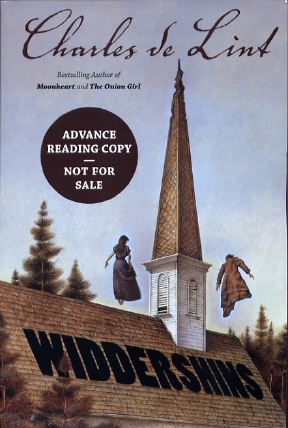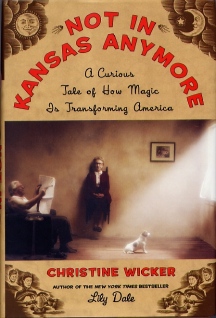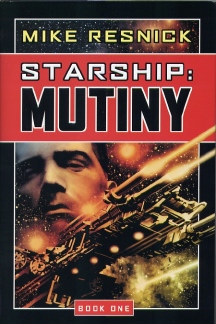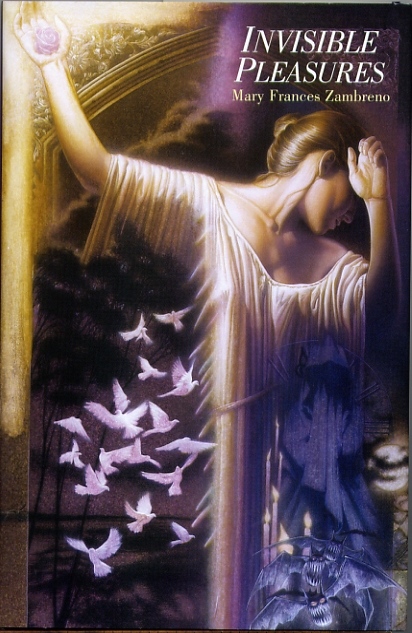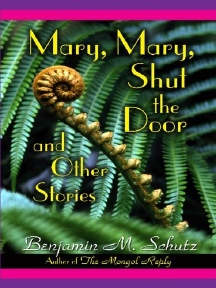|
|
|
This Just In...News from the Agony Column
|
01-13-06: Working Late: Agony Column Podcast Featured in iTunes New and Notable; Charles de Lint Walks 'Widdershins' |
|||
| Working
Late For those who have not yet subscribed, and those who have, here's something unexpected -- The Agony Column podcast feed (use this link) is now featured on the Apple iTunes New and Notable page. If you haven't subscribed, and have iTunes, you might want to use their interface. I think the proper expression is: w00t!
|
|||
Welcome
to Friday the Thirteenth
But let's begin with the beginning and in this case, that's the wonderful title and cover illustration. Most readers of fantasy or horror know that widdershins means counter-clockwise. Happily, it's a word that my document prep application does not know and the program writes a nice little red line underneath widdershins every time I type it. And while I know it means counter-clockwise, I like the definition of "anti-clockwise," because the word is fraught with implications that phrase covers much better. In its most common SF&F usage, widdershins refers to the practice of walking "anticlockwise" around a church or some other religious monument. The theory is that doing so will enable you to walk "against the light" and enter the world of Faerie. From 'Childe Rolande' to Shakespeare to Robert Browning to Terry Pratchett, widdershins has been a simple way to step into a world transformed by magic. It's such a nicely goofy sounding word with subtly sinister implications that I've always loved the word itself, and seeing it on the cover of a book is certainly a way to make me pick up that book. Readers know that I'm something of a cover-image hound, and given that, I have to say that I love the image here, including the design and incorporation of the title. Alas I've just spent the last fifteen minutes trying to find 'Spirits in the Wires' and can't because I'm pretty damn sure it’s the same cover artist. Whoever it is did a superb job on both the design and illustration. It offers the perfect combination of wildness, beauty and a certain amount of heady danger that one expects to find within the novel. Updated: Several readers wrote to tell me the cover artist is John Jude Palencar, who indeed has done the de Lint covers for Tor since 'Forests of the Heart'. The cover design, which I though superb is by Irene Gallo. Thanks all for writing and refreshing my very small brain. I'll look forward to more work from both of these talented folks. And that's where the real meat of the matter is here, in the novel itself. At 560 pages, this is verging on the epic. The real question is where and to whom this book will be sold. There's always a big potential for crossover sales with De Lint's fiction, which has its feet so firmly planted in both our world and a faerie world that is beautiful and surreal. But given that this novel has a romantic slant to it, I'm wondering if it will sell big into the burgeoning market for romantic fantasy. It's probably too much to hope for, but readers know that recently Harlequin and Tor have launched lines that pump up the both the romance and the fantasy. In general, as you might expect, in these mostly MMPB titles, the fiction itself is pretty much cookie-cutter material, the kind of stuff you've been able to find in bodice-ripping fiction since time immemorial. The novels seem to serve as a conduit for the characters to disrobe and then engage in mostly off-screen sex. I understand the desire (NPI) to read such material. I'm always on the prowl for the occasional monster-book equivalent. But I prefer the real monster deal, such as Neal Asher. Charles de Lint certainly provides some of the bullet points of romantic fantasy but in a far more literate and literary manner and without any of the cheese. To my mind, there's a definite potential for this book to trample through that marketplace and take no prisoners. But the problem is that you really wouldn’t want to sell it in that manner, because you’d certainly alienate the core and peripheral audience that de Lint always appeals to. But when you've got a romance this strong and this well-realized, it seems a shame to let it slip past the romance readers who might actually enjoy something with a lot more heft than their usual fare. And then there's the other selling point, the main draw for this fiction, which is de Lint's iconoclastic sense of modern, urban fantasy. 'Widdershins' finds Jilly Coppercorn and Geordie Riddell smack dab in the middle of a conflict between the North American "animal people" and the newly arrived fairy folk. Each character is abducted to a surreal netherworld, and escape will involve resolving the conflicts between themselves as well as the wider war. De Lint is a master at what I'd call the "horseless fantasy", that is, fantasy fiction that does not involve horse-riding warriors battling in huge numbers on plains darkened with blood. It's fantasy that does not partake of J. R. R. Tolkien, but takes similar elements and plays with them in a more modern urban or suburban setting. It has much of the appeal of what in the 1980's was called horror fiction, but the primary purpose here is not to frighten and there no real gore. But readers who like the surreal and the supernatural should definitely learn to walk 'Widdershins'. The bottom line is that de Lint anchors everything here in his characters. These are not larger-than-life heroes, raising swords to blood-strained skies. These are people like the people you know, but they've stepped into a sort of Otherworld that will be quite familiar to readers of say, Arthur Machen, Charles Fort or Patrick Harpur. 'Widdershins' is a pretty great reason to celebrate. It's the return of de Lint to his hometown of Newford and it's the return of fantasy to our world. Open up your door. Open up this book. Something invisible -- but tangible -- will enter your world. |
|
01-12-06: Christine Wicker is 'Not In Kansas Anymore'; With a Y |
||||||
Magic
Transforms America
But of course, magic can also denote what I find myself forced to call real magic, that is, the use of supernatural forces to change or explore the world in some fashion. That's part and parcel of the novels I love to read, from fantasy to horror and even science fiction, where a bit of handwaving magically transforms magic into psychic powers and quantum effects. Magic is not part of my experience of reality other than the part it plays in the fiction I read. Or so I would have said, even though I'm interested in all manners of Fortean phenomena. But 'Not In Kansas Anymore: A Curious Tale of How Magic is Transforming America' by Christine Wicker (HarperCollins; October 2005 ; $24.95) makes a pretty great case for the idea that magic, definition two -- in both fact and fiction -- is, well, transforming America. Wicker started the project as a skeptic, simply wanting to write about it as a social trend, you know, what the publicity notes call, "Santeria in the suburbs." Right. Makes for a nice blurb. But she makes some interesting points in here, and doesn't let her preconceptions get in the way of what she apparently found. First off is the idea that so-called "Magical thinking" is becoming ever more common, and that's what really got to me. Many of us, she contends, observe our lives through a filter of magic. We find ourselves struck by circumstances of "synchronicity" and observing omens and portents. That really stopped me, because, like it or not, I know that I tend to think in these terms, even if I dismiss the whole supernatural aspect. It doesn't matter whether or not I believe in magic as a concrete, real force one cannot see -- sort of like gravity. I still think that if I see three identical red cars that the world is somehow trying to send me a message about red cars. I have no idea what that message might be, but my tiny brain cannot help but see some organizing principle beyond pure chance, or within pure chance. I might not have any clue as to what the principle is, nor what the message is, but my experience is filtered through this idea of, well, magic. Even if I dismiss it immediately, the filter is still there. But Wicker goes beyond the everyday omens. She wanted to investigate what she perceived as a social trend. So, she investigates rituals and attends conventions, and takes part in all manners of bunkum and hooey, or rather, magic and the supernatural -- your call, right? The one message she got was that you had to surrender, to believe, to connect, to something. After being hammered for a year, she decided to finally give it a shot. And presumably, found herself, not to put too fine a point on it, "not in Kansas anymore." So what you get with this book is a look at all the quiet part of the America where, yes, sigh, "muggles" and the magical meet up at the local chain coffee store for a cuppa. Readers looking for grist for the mill will find at least 275 pages (with a bibliography) of portraits of Americans who believe in more than just omens and synchronicity. It's America the Eccentric. And in case you’re wondering how I came across this book so long after the fact, here's one more reason why I volunteer over at KUSP. I had to have this book literally thrust into my hands not once, not twice but three times by one of my literary comrades after a meeting. I looked at it innumerable times sitting on the bookshelf and it made nary a dent in my most-non-magical consciousness. It was no more than perseverance, persistence of vision and not my own persistence of vision. I even looked at the picture of Grandma on the Wall many times before it registered. (Wait for it....) Magic played no part whatsoever in placing this book in my hands. Or did it? |
||||||
Charlie
Huston Responds
Folks at Agony, At the risk of being regarded unprofessional I’ve decided to broach the barrier between reviewer and reviewed. Fuck the barrier, I say, fuck it hard. So and thus. Enjoyed the review of Already Dead. Deeply flattered to be grouped with many of the other writers you mentioned. Feel utterly nailed on the vampire with a Y thing. Got me. I swear I stared at the Y for a looong time before I went with the bastard. Pretentious, is what I thought. Poofy is, sadly, more accurate. I had just about decided to dump it when I hit on spelling virus with a Y as well. At the time I liked it. Thought it was kind of cool. Cool if you spell cool p-o-o-f-y. Oh well, life it made of regrets, what you do with them is another matter. Too late to go back now, the second book is in the bag. charlie www.pulpnoir.com
According to this story from the Star Tribune, Sharkey is running on a 13 point platform that includes impalment in front of the State Capitol of "terrorists, rapists, drug dealers, child abusers, repeat drunken drivers and anybody who preys on the elderly." This is definitely not poofy, and he does spell his Vampyre with a Y. ""I'm going to be totally open and honest," he said. "Unlike other candidates, I'm not going to hide my evil side." Readers who wish to learn more can go to his website, where he talks the talk and walks the walk. In a land where The Terminator can "run" the fifth largest ecomony in the world, it's not so outlandish that this gent could set up shop, and raise the stakes in the campaign for governor. |
|
01-11-06: Mike Resnick's 'Starship Mutiny' |
|||
The
Bounty of Birthright
Let me make this clear. While I in general prefer to read the weirder, more outré works from the world of genre fiction, I do enjoy more "normal" writers as well. I certainly enjoyed 'Dune: The Butlerian Jihad', and that's about as regular and normal as science fiction gets. So I'm not dead set against anything that looks like what most folks think of as "SF". That said, when I pick up a Pyr Book, I expect something pretty odd in some way. So when I first saw Mike Resnick's 'Starship: Mutiny', I frankly didn't know what to make of it, and wasn't all that interested. It looked like the kind of stuff that put me (mostly) off the genre in the eighties and nineties. The outline of the story is certainly pretty familiar as well. You've got your Galactic Federation, er Republic, or which humanity is a vital but not dominant force. You've got that now-familiar-to-us-in-the-present "permawar" with the Teroni Federation, who resent America's^H^H^H^H^H^H^H^H^Hhumanity's growing importance. That war is pretty hot at the galactic core, where all the important action takes place. But out on the good ol' spiral arm (rhymes with "rural farm") you've got the rejects and the retreads busting about in a downrev ship protecting, in this case, the Phoenix Cluster, some 73 inhabited worlds. Not much action out there, and it's the perfect place to stash the sort of hothead who specializes in Pyrrhic heroics. You know, the kind of stunts that wind up with amazing victories and like, one survivor. Said hero/zero in this case is Wilson Cole, transferred to the Theodore Roosevelt after two disastrous victories. Hey, that term sounds pretty familiar to those of us in the here-and-now as well. So. The Republic has stashed Cole here, as second officer (third in line) because the likelihood of enemy attacks is pretty low. Funny how the future seems to forget the SF of the past, innit? Well, chances are in "Book One" of a five book series, the bad guys will show up where they're least expected, other than by those who read moldy speculative fiction. Maybe not moldy. Presumably the tech that takes us to the stars can do something about mold. So. All this in 254 pages of the first book of a five book series, set in the "Birthright Universe" with another 30 pages of appendices covering the origin of the universe, the layout of the universe, and even -- get this! -- Teddy Roosevelt, "The Man Behind the Spaceship." Because, lamentably, not only do we not read SF written in the past about the present, we don’t even read history, and thus, often are unable to learn from it. It was only when I finally got the hardcover that it clicked for me. I'd never, up until this moment, held a Mike Resnick hardcover. I had plenty of MMPB anthologies with his award-winning work, but I'd never seen a Resnick HC. So there was a sort of disconnect that took place. Kind of like flipping on a light switch in a dark room, once I saw the hardcover, I started to grok that I indeed might like this and like it very much, in part because at least in Part One, there's not so much to like. Brevity is not just good, it's great. What you have here is no less than a single-minded space opera series by a guy who's been working on this universe -- so we learn in one of those appendices -- for a quarter century. And all of a sudden Lou Anders' pick starts to seem very very smart, and the hardcover on the Rolling Shelves pops right out into my frigid fingers. (Here in NoCal we have astronomical price increases in natural gas and astronomical decreases in payable-to-PGE dollars, so I NEVER turn on the heater during the day.) End result? I have not just one -- but five books to look forward to. I know that in the fullness of time they will be sitting on the shelves together. And I learn a valuable lesson, that being both a lesson and valuable, alas, I'm likely to quickly forget. Unless I start reading old SF, say, 1950's vintage, set in the year 2005. Or even....history. No, scratch that. History is best experienced as one reads the words 20 TONS on the bottom of an Acme Anvil for the second time. |
|
01-10-06: Mary Frances Zambreno Sees 'Invisible Pleasures' |
|||
Confessions
of a Goldfish Killer
'Invisible Pleasures' is that rarity that should not be a rarity, a collection of short stories by a genre fiction author. Zambreno sharpened her goldfish-snuffing teeth in the best of publications, the late lamented 'Pulphouse', where that lively little tale first appeared. Her work has appeared in a variety of genres and outlets, from 'Chilled to the Bone' (where the short story "Heavy Breathing" first popped up) to Marion Zimmer Bradley's Fantasy Magazine, where "The Fire Rider" was given the breath of life. So what you're looking at getting here is a collection with a range from high fantasy to low horror, with a dab of everything in between. It's not untypical of the fine work that one finds when one subscribes to a few of the genre magazines out there. Undiscovered gems of genre fiction are not so rare after all, and they're a lot easier to deal with for me when they come packed together in a nice collection like this. You'll find four new titles here, and each story is preceded by an introduction, most of which are not so incriminating as the one that really caught my eye. Of course, that probably says more about me than this book. Zambreno is already known as a novelist for Young Adults, these days the Holy Grail of publishing. 'A Plague of Sorcerers' was included in a list of Best Books for Young Adults back in 1992; the sequel 'Journeyman Sorcerer' was recognized by the New York Public Library in 1994. The fact that she was a columnist for American Fantasy magazine probably helped her land a deal with American Fantasy Press, a publisher I'd not heard of until this book landed in my inbox. That said, they've done a wonderful job producing this book. The cover art by Douglas Klauba is beautifully printed, one of those mélange paintings that draws on several stories and gives a pretty good idea of the range you'll find within. Despite the fact that they’re a small press, they've kept the price way down at 25 bucks. And this for what in other circles would be billed as a limited edition of 500 copies. If you’re looking to add another story to that tower at your bedside, then 'Invisible Pleasures' -- the kind you experience reading, which says something about this book -- is a great way to top it off. |
|
01-09-06: Benjamin Schutz Commands 'Mary, Mary Shut the Door' |
|||
A Five Star Selection of Stories
Schutz provides a very entertaining and informative introduction to the entire collection that serves as a good guide as to whether or not you're going to like the fiction that follows. He's not the kind of guy anyone is going to describe as particularly poetic. Instead, he offers the kind of up-front honesty that at first seems a bit simplistic, but builds into something rather complex. The variety here is part of the attraction and Schutz has helpfully organized his stories, grouping them around the types of protagonists he's writing about. The first selection of stories covers "Private Eyes" -- Matt and Sean Ellis, Leo Haggerty and "Max Barlow." Matt and Sean Ellis are based, he tells us in his disarming introduction, on his sons, "who worked as private eyes/process servers for a couple of summers in college. I remember what they said about the job. They liked it because it had consequences; it had impact; and you had to think on the run. Not like mis-flipping a burger." Now, for me, a guy who talks about his kids' summer jobs and burger-flipping gets a couple of bonus points going in. The first story about them was a finalist for the Ellery Queen Mystery Magazine Reader's Award, and the second, "Till Death Do Us Part", was written for this collection. You get three Leo Haggerty Stories, including the title story. And the final entry in the PI section is "The Black-Eyed Blonde", written for a collection of Chandler pastiches. Schutz has gone through the story and changed the name of Philip Marlowe to "Max Barlow," even though a couple of computer guys who analyzed the prose in the collection found him to be "the fifth closest to Chandler's style." Oh the joys of academia! The next section in the book features his forensic psychologist (read: profiler) stories. Doctor Ransom Triplett, who was in a peer supervision group with Dr. Morgan Reece in 'The Mongol Reply', shows up here in "Expert Opinion" and "Not Enough Monkeys". The final story in this section is a wonderful literary pastiche titled "The State Versus Adam Shelley", a modern take on the fate of Frankenstein's monster. It's an outstanding piece of writing, simultaneously hilarious, thought-provoking and deeply disturbing. The SWF/satire readers of this column should definitely give this one a bookstore read, as it will convince you to take the book home and make people look funny at you in the bookstore. Even if you have it in the collection 'The Ultimate Frankenstein' from the late (and much missed) Byron Preiss, it's nice to see it here presented against the backdrop of mystery fiction. It is truly weird yet presented as a pedestrian, pedantic report. The following section offers a couple of cop stories, "infused with my brother's experience as a Washington, D. C. police officer." And finally, Schutz offers an atypical (he says) for him tale of two serial killers, "or what happens when two cats mistake each other for mice." And I guess that sort of summarizes what I liked about Schutz. He comes off as a personable, sort-of interesting guy who then stings you with a zinger, a witty, intense and yet low-key bit of writing that stays with you after you're done reading. Add to that the very nice Five Star presentation. A creepy cover image -- those sorts of ferns have scared me since an early episode of The Outer Limits saw one springing to life to strangle another flower in a small spaceship garden -- and nice white paper. I like nice white paper. It makes the books easier to read, and one of these days I'm going to find out why it's not more common. But until then, I've got 327 page of 'Mary, Mary Shut the Door' to enjoy reading. And happily, as a result, a new-old publisher to look at. A glance at the colophon page states that this was "Published in 2005 in conjunction with Tekno Books and Ed Gorman." That explains a lot. Gorman is himself a prolific presence in the community, and prone to the kind of variety we see here. It won’t be another year before we look at a Five Star book. |

